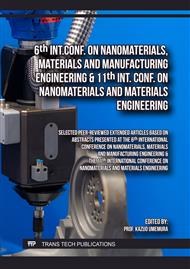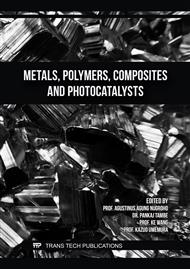[1]
Li, W., et al., Understanding the atomistic deformation mechanisms of polycrystalline γ-TiAl under nanoindentation: Effect of lamellar structure. Journal of Alloys and Compounds, 2020. 828: p.154443.
DOI: 10.1016/j.jallcom.2020.154443
Google Scholar
[2]
Lapin, J., et al., Hot deformation behaviour and microstructure evolution of TiAl-based alloy reinforced with carbide particles. Intermetallics, 2020. 127: p.106962.
DOI: 10.1016/j.intermet.2020.106962
Google Scholar
[3]
Galetz, M.C., et al., Oxidation-induced microstructural changes of the TiAl TNM-B1 alloy after exposure at 900° C in air. Intermetallics, 2020. 123: p.106830.
DOI: 10.1016/j.intermet.2020.106830
Google Scholar
[4]
Laska, N., R. Braun, and S. Knittel, Oxidation behavior of protective Ti-Al-Cr based coatings applied on the γ-TiAl alloys Ti-48-2-2 and TNM-B1. Surface and Coatings Technology, 2018. 349: pp.347-356.
DOI: 10.1016/j.surfcoat.2018.05.067
Google Scholar
[5]
Gong, X., et al., Synergistic effect of B and Y on the isothermal oxidation behavior of TiAl-Nb-Cr-V alloy. Corrosion Science, 2018. 131: pp.376-385.
DOI: 10.1016/j.corsci.2017.12.013
Google Scholar
[6]
Naveed, M., A.F. Renteria, and S. Weiß, Role of alloying elements during thermocyclic oxidation of β/γ-TiAl alloys at high temperatures. Journal of Alloys and compounds, 2017. 691: pp.489-497.
DOI: 10.1016/j.jallcom.2016.08.259
Google Scholar
[7]
Cheng, J., et al., Electrochemical corrosion and tribological evaluation of TiAl alloy for marine application. Tribology International, 2017. 115: pp.483-492.
DOI: 10.1016/j.triboint.2017.06.027
Google Scholar
[8]
Distl, B., G. Dehm, and F. Stein, Effect of Oxygen on High‐temperature Phase Equilibria in Ternary Ti‐Al‐Nb Alloys. Zeitschrift für anorganische und allgemeine Chemie, 2020.
DOI: 10.1002/zaac.202000098
Google Scholar
[9]
Dahar, M.S., S.A. Tamirisakandala, and J.J. Lewandowski. Integrated Computational Materials Engineering of Gamma Titanium Aluminides for Aerospace Applications. in MATEC Web of Conferences. 2020. EDP Sciences.
DOI: 10.1051/matecconf/202032108002
Google Scholar
[10]
Bibhanshu, N., A. Bhattacharjee, and S. Suwas, Hot deformation response of titanium aluminides Ti–45Al-(5, 10) Nb-0.2 B-0.2 C with pre-conditioned microstructures. Journal of Alloys and Compounds, 2020. 832: p.154584.
DOI: 10.1016/j.jallcom.2020.154584
Google Scholar
[11]
Tlotleng, M. and S. Pityana, Effects of Al and heat treatment on the microstructure and hardness of Ti–Al synthesized via in situ melting using LENS. Metals, 2019. 9(6): p.623.
DOI: 10.3390/met9060623
Google Scholar
[12]
Školáková, A., et al., Kinetic and thermodynamic description of intermediary phases formation in Ti-Al system during reactive sintering. Materials Chemistry and Physics, 2019. 230: pp.122-130.
DOI: 10.1016/j.matchemphys.2019.03.062
Google Scholar
[13]
Kanyane, L., et al. Microstructural evolution and nano-mechanical properties of Ti-Al-based alloys synthesized by laser in-situ alloying. in MATEC Web of Conferences. 2022. EDP Sciences.
DOI: 10.1051/matecconf/202237003001
Google Scholar
[14]
Knaislová, A., et al., Effect of alloying elements on the properties of Ti-Al-Si alloys prepared by powder metallurgy. Journal of Alloys and Compounds, 2021. 868: p.159251.
DOI: 10.1016/j.jallcom.2021.159251
Google Scholar
[15]
Wei, D., et al., Microstructure, nano-mechanical characterization, and fretting wear behavior of plasma surface Cr-Nb alloying on γ-TiAl. Proceedings of the Institution of Mechanical Engineers, Part J: Journal of Engineering Tribology, 2020: p.1350650120939835.
DOI: 10.1177/1350650120939835
Google Scholar
[16]
Raji, S.A., et al., Characteristic effects of alloying elements on β solidifying titanium aluminides: A review. Heliyon, 2020. 6(7): p. e04463.
DOI: 10.1016/j.heliyon.2020.e04463
Google Scholar
[17]
Iijima, D., et al., Wear properties of Ti and Ti–6Al–7Nb castings for dental prostheses. Biomaterials, 2003. 24(8): pp.1519-1524.
DOI: 10.1016/s0142-9612(02)00533-1
Google Scholar
[18]
Fischer, F.D., et al., Study of nanometer-scaled lamellar microstructure in a Ti–45Al–7.5 Nb alloy–Experiments and modeling. Intermetallics, 2010. 18(4): pp.509-517.
DOI: 10.1016/j.intermet.2009.09.012
Google Scholar
[19]
Cheng, J., et al., High temperature tribological behavior of a Ti-46Al-2Cr-2Nb intermetallics. Intermetallics, 2012. 31: pp.120-126.
DOI: 10.1016/j.intermet.2012.06.013
Google Scholar
[20]
Wang, J., et al., Microstructure characteristics and failure mechanisms of Ti-48Al-2Nb-2Cr titanium aluminide intermetallic alloy fabricated by directed energy deposition technique. Additive Manufacturing, 2020. 32: p.101007.
DOI: 10.1016/j.addma.2019.101007
Google Scholar
[21]
Ye, L.-H., et al., Phase stability of TiAl-X (X= V, Nb, Ta, Cr, Mo, W, and Mn) alloys. Journal of Alloys and Compounds, 2020. 819: p.153291.
DOI: 10.1016/j.jallcom.2019.153291
Google Scholar
[22]
Bresler, J., et al., The influence of niobium, tantalum and zirconium on the microstructure and creep strength of fully lamellar γ/α2 titanium aluminides. Materials Science and Engineering: A, 2019. 744: pp.46-53.
DOI: 10.1016/j.msea.2018.11.152
Google Scholar
[23]
Neumeier, S., et al., Partitioning Behavior of Nb, Ta, and Zr in Fully Lamellar γ/α2 Titanium Aluminides and Its Effect on the Lattice Misfit and Creep Behavior. Advanced Engineering Materials, 2021: p.2100156.
DOI: 10.1002/adem.202100156
Google Scholar
[24]
Kanyane, L.R., et al., Heat-treatment effect on anti-corrosion behaviour and tribological properties of LENS in-situ synthesized titanium aluminide. International Journal of Lightweight Materials and Manufacture, 2022. 5(2): pp.153-161.
DOI: 10.1016/j.ijlmm.2021.11.006
Google Scholar
[25]
Dai, J., et al., High temperature oxidation behavior and research status of modifications on improving high temperature oxidation resistance of titanium alloys and titanium aluminides: A review. Journal of Alloys and Compounds, 2016. 685: pp.784-798.
DOI: 10.1016/j.jallcom.2016.06.212
Google Scholar
[26]
Donchev, A.G. and M.C. Galetz, The Importance of the Fluorine Effect on the Oxidation of Intermetallic Titanium Aluminides, in Intermetallic Compounds-Formation and Applications. 2018, IntechOpen.
DOI: 10.5772/intechopen.75696
Google Scholar



